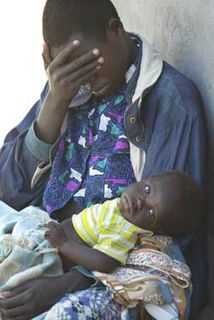The Child-Mothers of Uganda

Child-mother Janet, who was abducted at age ten,
cries as she holds her eleven-month-old son at a
rehabilitation center in Northern Uganda on Nov. 20, 2003.
(Photo: Marco Longari/AFP-Getty Images)
UPDATE: The U.S. continues to enhance its image as a backwards-thinking, narrowminded nation. Read Pam's House Blend's U.S. to U.N.: All your wombs should belong to us.
-----------------------------------------------------------------------------------------------
Dear President Bush,
At least you don't have to worry about these girls getting abortions. I guess that makes you sleep easy at night.
Ms. Julien in Miami
In keeping with the Africa-based theme began by Pam's House Blend, and carried on by Shakespeare's Sister, I offer this post as a reminder of what is going on in Africa. As I posted earlier in the blog, demands for oil (which ain't Africa's strong suit) "trump" the concern for genocide. This article is an excellent study on the "child mothers" - the ones that Bush is SO afraid might learn about abortions. Of course, while he is peeing his pants about that, he certainly isn't sweating much about the plight of these girls.
An excerpt (bold accents by Julien's List):
Mothers all over the world have hopes and dreams for their children. In ordinary circumstances, such hopes and dreams often come true.However, that cannot be said of the child-mothers in Northern Uganda.
They were children themselves — now child-mothers, created by an 18-year-old war between President Museveni and the Lord’s Resistance Army (LRA) led by Joseph Kony
These child-mothers, between 15-23 years of age, lived in captivity for more than ten years after unwillingly being taken to Sudan and indoctrinated into the ways of Kony rebels, where they were used as sex objects, raped, defiled and forced to be “wives” to rebel commanders.
Even girls 12 years of age and younger were not spared. They have now come back to Uganda pregnant or with malnourished babies, to face the challenges of raising their children single-handedly. They live in fear and misery, constantly reliving their maltreatment, scarred permanently by their horrendous experiences of the sexual abuses they endured.
In the bush they faced the burden of unwanted pregnancies and the risk of sexually transmitted infections, including HIV/AIDS, estimated to be as high as 30%, which is their major worry. And due to the unhygienic conditions in the bush, many of their children have come back with severe skin infections and illnesses.
The war in the region destroyed all the infrastructure, escalated HIV/AIDS infection, created bad governance, and has squeezed and incarcerated 1.6 million internally displaced people (IDPS) into approximately 66 camps.
Political repression, illiteracy, ignorance, disease and abject poverty have become commonplace.
How child-mothers are to realize their hopes and dreams and those of their children under such conditions is a question we must all ask ourselves.
With their parents murdered, homes burned-out, relatives not willing to accommodate them and the fathers of their children either dead or unable to live up to their responsibilities, life is extremely hard for these child-mothers as they look for ways to raise their “families” completely alone.
“I have three children and I don’t know where their father is. I last saw him when I was pregnant with the third child. My parents were murdered in Pagak camp and my relatives cannot take care of me because their conditions are just as bad as mine. I just have to struggle on my own and see that my children do not suffer. I pray that some Good Samaritan may come to my rescue,” says Evelyn Acha, a 19 year old who was abducted by Kony rebels when she was eleven.
Because of the breakdown in the social order, nobody really knows the exact number of child-mothers. According to statistics at the World Vision Centre of Uganda Children of War and Gulu Support the Children Organization (GUSCO), a conservative estimate puts the number of child-mothers who have come through Gulu centers alone, at over 4,000. The total number for the whole of Northern Uganda is unknown.
The rest of the article is HERE.






